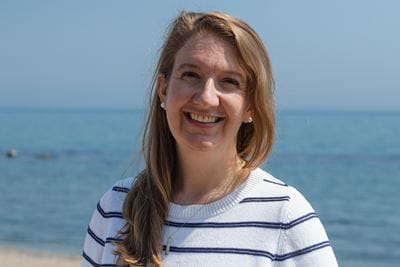
Why is it so important for older adults to participate in arts-based activities?
 by Meagan Kashty – Sep 23, 2022
by Meagan Kashty – Sep 23, 2022 
In Take 5, Sheridan's thought leaders share their expert insight on a timely and topical issue. Learn from some of our innovative leaders and change agents as they reflect on questions that are top-of-mind for the Sheridan community.
It’s no secret that food, exercise and sleep are some of the key pillars to staying healthy. But can flexing our creative muscles also help us thrive as we age?
 As Schlegel Innovation Leader in Arts and Aging at Sheridan’s Centre for Elder Research (CER) and the Schlegel UW Research Institute for Aging, and professor in the Faculty of Applied Health and Community Studies, Dr. Kate Dupuis seeks to identify both the personal and systemic barriers to participation in the arts, and how we can facilitate arts engagement in older adults.
As Schlegel Innovation Leader in Arts and Aging at Sheridan’s Centre for Elder Research (CER) and the Schlegel UW Research Institute for Aging, and professor in the Faculty of Applied Health and Community Studies, Dr. Kate Dupuis seeks to identify both the personal and systemic barriers to participation in the arts, and how we can facilitate arts engagement in older adults.
Working with older adults living in both in the community and in communal settings such as retirement and long-term care homes, she strives to understand how arts can benefit all domains of health and well-being, and has witnessed first-hand the benefits of the arts as she transitioned her research activities to virtual delivery over the pandemic.
For example, as an evaluative consultant to Concerts in Care Ontario, Dr. Dupuis worked with four senior access living centres across the province to provide her observations of reactions and interactions of older adults as they attended live concerts virtually. She also fostered a collaboration for Sheridan’s CER with the Alberta WP Puppet Theatre, where she examined the benefits of the WP Puppet Theatre’s “VIEW from the Insider” virtual program, which invites participants to explore their creativity and self-expression through the creation of a self-portrait puppet.
Also significant for Dr. Dupuis was a partnership with Baycrest Health Sciences and artist and Sheridan professor Elaine Brodie. Titled MAPArts: Memory Enhancement and Art Creation, Dr. Dupuis and professor Brodie worked with participants to create a memory box that represented their learned skills and concepts related to memory formation.
In advance of Arts & Aging Day on Sept. 24, we asked Dr. Dupuis to share some of her expertise into the effects of arts-based activities for older adults.
What first spurred your interest in arts and aging?
I’ve always been really interested in the arts. I love musical theatre, and I love to watch ballet. I had been working on my (postdoctoral fellowship in the Neuropsychology and Cognitive Health and Hearing Services programs) at Baycrest, which is a geriatric research and teaching hospital. I’d been working with a lot of older individuals looking at issues related to communication and quality of life. I came across the job posting for Schlegel Innovation Leader at Sheridan and thought it would allow me to continue in this space of looking at quality of life, communication and connection, but through the arts lens. It just seemed like a very natural fit.When I was younger, I wanted to be an art historian. So, I had always been very interested in studying the arts…looking at how people connect with the arts and what the arts means to people. I discovered abnormal psychology as one of my electives and fell in love with psychology and went in that path for my career. So, I always find it very interesting that my life seems to have come a little bit full circle back with the arts and creativity and self-expression and, more specifically, working with an older population.
What are what are the key benefits you see when older adults participate in arts-based activities?
It really depends to some degree on the art form, as well as the research and the questions being asked. I do some work with the team at Toronto Metropolitan University where we look at the physiological benefits of group singing. If you look at salivary hormonal readings during, before and after group singing, some research has actually suggested that cortisol levels — the stress hormone in the body — can reduce, while oxytocin — the hormone related to social connection and bonding — actually increase.A lot of the work that I do looks at the social connection and communication benefits of participating in the arts. But with much of the work that we've done during COVID, we've also looked at ideas of confidence, comfort and self-efficacy. We look at how people feel about their own abilities, pre and post intervention, and how comfortable they feel with the materials before and after their education in the space, and how good they feel about their ability to engage in the arts.
We have had a lot of novices who have just thrilled us and really shocked themselves with what they were able to create. We heard during the pandemic so much about social isolation and mental health concerns, and we saw a lot of self-reported benefits to the mental health and well-being of our participants in arts-based research.
When we opened up a Zoom call for two hours to do our research, you’d think it would have different results, being in a separated space, but it's similar to what we would see if we were doing things in person around a big table. While we were working together, folks would sip their coffee, and talk about movies, or something funny their kids did. These small person-to-person interactions and connections were really important, especially at the very beginning of COVID when a lot of older adults were shielding themselves. The media was telling older adults to stay home – that it was dangerous to go outside. There has been so much ageism in our response to COVID. I think this was a really empowering way for people to connect with one another and to feel that they had done new things.
What has your research focused on at Sheridan?
When I began at Sheridan in 2017, it was a new role, so I was able to build it from the ground up, which was really nice. I spent a lot of time looking at the benefits of arts participation. Today, my role has shifted away from only looking for more evidence that the arts are helpful. I don't really think we need that proof anymore. But what I'm really interested in is access to the arts and what the arts actually means to people.There's often a lot of self-stigma when we hear the word “art” or “artistic”. We each have our own understanding of how artistic or creative we are. We may have had a moment in our childhood or in our youth where someone made comments to us about our artistic abilities, and that may have shaped how we were able to engage in the arts growing up.
Other folks may not have had the funds, or may have lived in a location where there wasn’t a lot of access to arts-based programing. They may not have had the time or the interest. So, trying to tell people that participation in the arts is part of a healthy aging framework is sometimes surprising to people. The average person knows about the importance of getting good sleep, exercising, and trying not to stress too much — but they may not understand that everyone is artistic in their own way. Everyone can be creative. So that's where a little bit of my research is going.
I have a Social Sciences & Humanities Research Council (SSHRC) Insight grant with a colleague at the University of Toronto, and we're about to launch a project where we look at this idea of one's own abilities and perceptions of their artistic abilities and how that interacts with your feelings about your own aging process. I call it “artism” — kind of like ageism. We’re asking specific questions to participants about the seminal moment in their lives when someone made a comment about their ability to engage in the arts.
Can you expand a bit on the issue of access when it comes to arts and aging, and what you see as some of the biggest barriers?
Before the pandemic, we had done some work to look at barriers and facilitators to arts participation.One key barrier we found was transportation. We're working in Oakville…it’s a large area, where access to transit isn’t great. A lot of older individuals aren’t driving anymore, so this was a big issue for them. But with arts programming delivered remotely during COVID, participants enjoyed using the Zoom online platform because it was easier - they didn't have to drive anywhere or leave early if they had another appointment to make.
Some other barriers included not wanting to participate on their own. Just like in every age group, you're more comfortable doing things when you're with someone you know. Potential solutions to that could include creating a buddy system before the first session so participants could be tagged with someone from the get go.
Cost was identified as a key thing many seniors in Canada were concerned with. We know that many older adults are living on very restricted budgets, so even a program of a few hundred dollars a term could be very expensive for them.
A lot of participants that replied to our survey of almost 200 people said they're just not interested in the programming being offered, or what's being offered isn’t quite a fit – it might be run by people who clearly have never worked with older adults before and perhaps have their own ideas about what older adults are capable of.
It’s really talking about being able to pick up the arts in any way at any time. It can be watching YouTube videos at your house, or it can be taking a more formalized program. Oakville has its own programming, as do most other cities. If you're not interested in that programming, there's a lot of other things that you can do. But now, you don't have to just take classes. You can try things out on your own or go online to see.
So those were some key barriers that we had identified previously: transportation costs, interest in available programing, and also lack of a community essentially to participate with.
What misconceptions have you seen when it comes to arts and aging?
I think everyone who has participated in our programing can clearly see some sort of benefit for themselves. Those are the converted. But I also think there's a large group of individuals that believe you can't teach older people new things. That the skills that you have and the skills that you've developed are the skills that you will age with.
But we know, from a brain function perspective, that there’s neuroplasticity. We know that your brain can change your whole life, and we know that people can learn new things and can excel in their own way at new things.
I also think some people have some misconceptions in terms of what's successful or what’s considered “good” art. They don't want to take a chance because maybe they're a little worried that it won't look like what they've seen in a museum or in a book. But what we've found from some of our research is that people have surprised themselves. We had one participant who came to a memory intervention session, loved it, and then after attending an art-making session later that week, called me up and told me they couldn’t continue with the project. They felt they weren’t as good as the other people and it wasn’t for them. I told them that while we would never force them to attend and show us their work, they were more than welcome to continue to participate. We would never single them out.
So, they ended up staying in the program, and when the session ended in February 2022 and we had an in-person gathering, they were was able to show me their massive portfolio. They had continued engaging in the arts, and was asking me to send more programs their way. So, this person had an idea of what it would be like to take an art course, and was not happy with their own performance at the beginning. There was a bit of motivational counselling, which is essentially when they realized that there is no right or wrong, as long as you enjoy what you’re doing.
Interested in connecting with Dr. Kate Dupuis or another Sheridan expert? Please email communications@sheridancollege.ca.
The interview has been edited for length and clarity.
Media Contact
For media inquiries, contact Sheridan’s Communications and Public Relations team.



